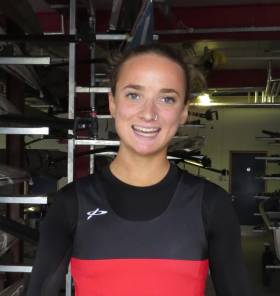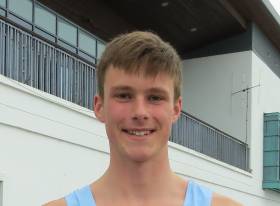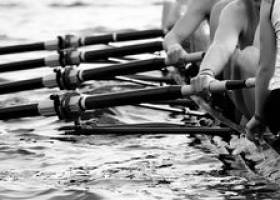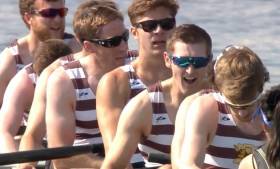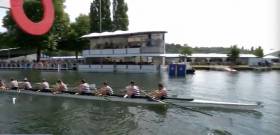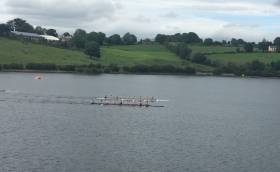Displaying items by tag: Cork Boat Club
Cremen and Dorney Top Rankings on Cork Sculling Ladder
#Rowing: Jack Dorney of Shandon and Margaret Cremen of Lee were the overall winners of the Cork Sculling Ladder. The presentations will take place this Thursday (January 31st) at Cork Boat Club. The Ladder is sponsored by Argos Fire.
Cork Sculling Ladder - Overall Winner : (1) Jack Dorney - Shandon Boat Club.
Women’s Overall Winner: (13) Margaret Cremen - Lee Rowing Club (retained)
Section Winners
Men
Jack Dorney - Shandon Boat Club, Open, Intermediate, Club 1, Club 2, Junior 18 and Junior 16
Jack Kiely - Lee Rowing Club, Novice
Peter Leonard - Cork Boat Club, Junior 15 and Junior 14
David Ross – Chu - Shandon Boat Club, Junior 13
Cian Dunlop - Lee Rowing Club, Junior 12
Donal Smith - Shandon Boat Club, Masters A & B
Henrik Merz - Shandon Boat Club, Masters C
John O’Neill - Shandon Boat Club, Masters D
Tony Corcoran - Lee Valley Rowing Club, Masters E, F, G & H
Women
Margaret Cremen - Lee Rowing Club, Open, Intermediate and Junior 18
Aoife Lynch - Lee Rowing Club, Club 1, Junior 16 and Junior 15
Claragh O’Sullivan - Cork Boat Club, Club 2
Maeve Coakley - Lee Rowing Club, Novice
Jennifer Forde - Shandon Boat Club, Junior 14
Isobel McElwain - Lee Rowing Club, Junior 13
Emer Hannon - Lee Rowing Club, Junior 12
Jessica Legresly - Shandon Boat Club, Masters A & B
Vivian Kelleher - Lee Rowing Club, Masters C
Liz Buckley - Lee Rowing Club, Masters D
Shandon Excel at Cork Head of the River
#Rowing: Shandon amassed a big set of wins at the Cork Head of the River at the Marina on Saturday. Their men’s senior quadruple, competing in the fourth head, set the fastest time of 12 minutes 3.4 seconds, while their men’s senior eight were just .6 of a second slower. They competed in head one and were the second-fastest crew overall. Jack Dorney was the fastest single sculler.
Cork Boat Club's women reeled off a set of wins. The fastest women’s crew was their club two eight, while Grace Collins of the same club was the fastest women’s single sculler.
Cork Head of the River, The Marina, Saturday (Selected Results)
Overall: 1 Shandon men’s senior quadruple 12 minutes 3.4 seconds (Head Four), 2 Shandon men’s senior eight 12 mins 4 secs (Head One), 3 Cork men’s inter eight 12:17.3 (H1).
Men
Eight – Senior: Shandon 12:04.0. Inter: Cork 12.17.3. Club Two: Shandon 13.13.
Four – Sen: Shandon 12:37. Inter, coxed: Shandon 13:55.3. Club Two, coxed: Waterford 15:41.6. Jun 18A, coxed: Shandon 14:13.3.
Pair – Sen: Cork A 13:44.1. Jun 18A: Fermoy 14:28.9. Jun 16, coxed: Presentation (Rolling Head) 14:24.6. Masters, coxed: Shandon (b) 15:17.4.
Sculling – Quadruple – Sen: Shandon 12:03.4. Inter: Shandon 12:36.2. Jun 18A: Lee B 12:53.1. Masters, coxed: Shandon A (a) Rolling Head 15:24.8
Double – Club Two: Shandon 15:27.5. Jun 18A: Cork 13:41.3.
Single – Sen: 1 Shandon (J Dorney, sen, H2) 15:18.8. Inter: Cork (C O’Sullivan) 15:44.7. Club Two: Lee (P Hearty) 18:11.1. Jun 18A: Lee (A Sheehan, H2) 15:30.2. Jun 16: Kenmare (T Kelly) 15:48.7. Masters: Shandon (H Merz, d; Rolling Head) 15:25.7.
Women
Eight – Club Two: Cork 14:28.5. Pair - Sen: Cork 16:47.2. Jun 18: Cork A 16:08.
Four – Club Two, coxed: Cork A 15:04.9. Masters, coxed: Cork (d) 16:38.4.
Sculling – Quadruple – Inter: Cork 15:27.3. Jun 18A: Shandon A 15:23.1. Jun 16, coxed: Lee 16:19.2. Masters, coxed: Graiguenamanagh (b) 17:15.2.
Double – Inter: Cork A 15:11. Jun 18A: Lee A 15:37.3.
Single – Inter: Cork (G Collins) 16:13.4. Club Two: Shandon (J Legresley) 16:01.5. Novice: Lee (O Commins) 17:35.9. Jun 18A: Kenmare (E Crowley) 15:38.7. Jun 16: Shandon (J Forde) 15:55.9. Masters: Shandon (J Legresley; b) 17:49.8 (Rolling Hd)
NUIG Take Women's Senior Four Title at Irish Championships
#Rowing: NUIG won the much-anticipated women’s senior four final at the Irish Rowing Championships today. Trinity made the early moves, but NUIG moved before halfway, with Commercial and Cork Boat Club also coming into contention. From there the Galway club took it and won from Commercial by over three seconds. Cork were third.
American Crews Oust Cork and NUIG From Henley
#Rowing: Cork Boat Club raced well but made their exit to New Jersey crew Montclare Mounties in the Thames Cup at Henley Royal Regatta. The Americans started powerfully and took an early one-length lead. Cork stayed calm and bit chunks out of the lead as the crews entered the enclosures area. Montclare would not yield: they finished well and won by three-quarters of a length.
NUIG secured an early lead and held it until the final stages of their race in the Prince Albert for student coxed fours. Columbia University then swept past and won by one and three-quarter lengths.
Yale, with Daire Lynch in the three seat, beat Princeton in a thrilling race in the Temple Cup. Princeton, who had trailed, darted to the line and came within a canvas of winning.
Henley Royal Regatta, Day Three (Irish interest; selected results)
Temple Cup (Eights, College): Yale (3 D Lynch) bt Princeton, canvas.
Thames Cup (Eights, club): Montclair Mounties, United States bt Cork Boat Club ¾l .
Prince Albert (Fours, coxed; Student): Columbia University, US bt NUIG 1¾ l.
Double Sculls (Open): G O’Donovan, P O’Donovan bt S Cox, T Oliver 4¾ l.
Cork March On at Henley Rowing Regatta
#Rowing: Cork Rowing Club moved smoothly into the second round of the Thames Cup at Henley Royal Regatta with a straightforward win this morning. They took an early lead over London Rowing Club ‘A’, and extended it to one length by half way. They stayed in their rhythm and a push by their opponents made little difference; they went on to establish a clearwater lead by the enclosures.
In the Double Sculls Challenge Cup, Tiernan Oliver, rowing with Leander for the summer, teamed up with Stephen Cox to win their heat. They will meet Paul O’Donovan and Gary O’Donovan tomorrow.
Henley Royal Regatta, Day Two (Selected Results; Irish interest)
Thames Cup (Eights, Club): Cork Boat Club bt London RC ‘A’ 1 ¾ l.
Double Sculls (Open): S Cox, T Oliver bt JJP Keech and JA Dunley 1 ¼ l.
Cork Boat Club Look Strong at Henley Royal Regatta
#Rowing: Cork Boat Club continued the winning run by Irish crews on the first day of Henley Royal Regatta. They beat Potomac of the United States by three-quarters of a length in the Thames Cup for club eights. The race was unusual in that Cork made a fine start but were passed by Potomac, who looked like they might take control of the race. Cork’s comeback was impressive: they cut down the lead and then passed Potomac. The Irish took charge and stayed in the lead to the end.
Earlier, Neptune had won their heat of the Fawley Cup for junior quadruples.
Henley Royal Regatta, Day One (Selected Results; Irish interest)
Thames Cup (Eights, Club): Cork Boat Club bt Potomac, United States ¾ l, 6 min 35 sec.
Fawley (Quadruple, Junior): Neptune bt Tideway Scullers’ School ‘C’ 2/3l, 7:04.
#Rowing: Two strong senior composite crews took home the Division One quadruple titles as the action concluded late into the evening on the first day of Cork Regatta at the National Rowing Centre. The women’s final saw Margaret Cremen join Skibbereen’s Lydia Heaphy, Denise Walsh and Aoife Casey to good effect, and the men’s winners were the prospective Ireland Under-23 lightweight quad. Workmen’s and Shandon junior 18 crews were good runners up in the women’s and men’s races.
Cork Boat Club won the Division One men’s coxed four title, while Trinity took the women’s.
Cork Regatta, National Rowing Centre (Selected Results)
Men
Eight – Div Two: Neptune (club two) 6:22.95; 4 Trinity (nov) 6:34.32; 5 Col Iognaid (jun 16) 6:35.63; 6 Shandon (jun 18B) 6:43.79.
Four – Div One, coxed: Cork (inter) 6:34.299; 3 Enniskillen A (jun 18A) 6:39.299. C Final: 2 Neptune (club one) 6:48.37.
Pair – Div One: 1 UCD (S Mulvaney, D O’Malley; sen) 6:53.31, 2 Skibbereen (M O’Donovan, S O’Driscoll; sen) 6:59.98, 3 Enniskillen (jun 18A) 7:06.75; 6 Cork A (inter) 7:23.68. B Final: 6 Neptune A (club one) 7:24.50.
Sculling, Quadruple – Div One: 1 Tara, UCD, Commercial, UCC (sen) 6:00.93, 2 Shandon (jun 18) 6:10.96
Double – Div Two: CRCC (jun 18B) 7:06.99; 5 Cork A (jun 16) 7:15.37. B Final: Cappoquin (club two) 7:20.43
Single Sculls: 1 Skibbereen (P O’Donovan; sen) 6:59.73. B Final: UCC (H Sutton; lwt) 7:20.63. C Final: 1 Shandon (E Gaffney; jun 18A) 7:28.92; 2 Queen’s (N Hull; inter) 7:29.86
Women
Eight- Div Two: Trinity A (club two) 6:52.696; 6 Commercial (jun 16) 7:15.45. B Final: 1 Queen’s (nov) 7:19.09.
Four, coxed – Div One: 1 Trinity (inter) 7:25.63, 2 Commercial (sen) 7:30.06; 5 Shandon (club one) 7:46.78.
Pair – Div One: 1 Skibbereen (A McCarthy, N Casey; sen) 7:49.73; 4 Col Iognaid (Jun 18A) 8:07.86; Shandon (club one) 8:08.78. C Final: 4 Shandon (inter) 8:36.00.
Sculling, Quadruple – Div One: 1 Skibbereen/Lee 6:50.49; 2 Workmen’s (jun 18A) 7:05.596. Div Two: 1 Cork A (club two) 7:50.05; 3 Carlow (jun 16) 8:03.97. B Final: Carlow (jun 18B) 8:13.43; 4 Queen’s (nov) 8:25.47.
Double – Div Two: 1 Killorglin (jun 18B) 7:41.63, 2 New Ross (club two) 7:56.41, 3 Carlow (jun 16) 8:00.41
#Rowing: Skibbereen added four titles to their already weighty tally on the first day of the Irish Rowing Championships at the National Rowing Centre today. Paul O’Donovan won the senior single sculls and teamed up with Mark O’Donovan, Shane O’Driscoll and his brother Gary in the senior four – both were done in new record times for the course. Paul and Gary also won the senior doubles. The Skibbereen women’s four also won well, in a new best time for the course.
NUIG also took four titles: the men’s intermediate coxed four and club eight and the women’s club coxed four and novice coxed quadruple.
Cork Boat Club proved best in the women’s intermediate eight and also won perhaps the best race of the day: Barry O’Flynn was severely tested by Jack Dorney in the junior single sculls but fought back after being passed and won by a length.
The Old Collegians victory in the women’s senior double was straightforward: Sanita Puspure and Claire Lambe were by far the best crew.
This was the last final of the day, while UCC had won the first, taking the men’s novice coxed quadruple.
Neptune and St Joseph’s tried to rein them in, but the men’s junior eights final was a surprsingly straightforward affair for winners Enniskillen, who also won the women’s junior four. Lee’s Margaret Cremen and Aoife Lynch were also in control in the women’s junior double, as were Hannah Scott and Katie Shirlow in the intermediate pair.
Irish Rowing Championships, National Rowing Centre, Day One (Selected Results)
Men
Eight – Club: NUIG 5:53.60. Junior: Enniskillen 5:47.96.
Four – Senior: Skibbereen 5:55.33. Inter, coxed: NUIG 6:13.38.
Sculling, Quadruple – Novice, coxed: UCC 6:39.37.
Double – Senior: Skibbereen 7:06.89.
Single – Senior: Skibbereen (P O’Donovan) 6:48.19. Junior: Cork (B O’Flynn) 7:04.06.
Women
Eight – Intermediate: Cork 6:22.06.
Four – Senior: Skibbereen 6:40.58. Club, coxed: NUIG 7:10.92. Junior: Enniskillen 6:57.94.
Pair – Inter: Bann 7:19.32.
Sculling, Quadruple – Novice, coxed: NUIG 7:36.02. Double – Senior: Old Collegians 6:59.997. Junior: Lee 7:09.86.
UCC/Skibbereen Women's Eight Win on the Line at Cork Regatta
#Rowing: The Skibbereen/UCC composite won the women’s eights with the final few strokes at the Cork Grand League Regatta today. NUIG led them coming up to the line, but the winners finished faster to win by three tenths of a second. Cork were the best junior 18 eight.
UCD won the men’s eights by holding off NUIG. The finish was close, but UCD had led down the course and refused to yield. Neptune took the junior 18 honours by holding off St Joseph’s of Galway in the B Final.
Cork Regatta, National Rowing Centre, Cork, Day Two (Selected Results)
Men
Eight – Division One – A Final: 1 UCD (N Farrell, R Thompson, E O’Connor, C O’Riada, E Gleeson, A Griffin, T Doherty, M Murphy; cox: O Reid; senior) 5:51.05, 2 NUIG (sen) 5:51.91, 3 UCD (inter) 6:05.098; 4 Cork (club one) 6:05.46. B Final: 4 Neptune (Jun 18A) 6:13.69.
Four – Div One – A Final: 1 NUIG (sen) 6:16.41. Four, coxed – Div Two – A Final: 1 Queen’s B (club two) 6:53.69, 2 St Michael’s (jun 18B) 6:56.53; 6 Presentation, Cork (jun 16) 7:33.61.
Sculling,
Quadruple, Div Two, coxed – A Final: 1 Carlow (jun 18B) 6:43.70; 3 Castleconnell (jun 16) 6:53.53; 4 Shandon (club two) 6:54.67.
Double – A Final: 1 Skibbereen (G O’Donovan, P O’Donovan; sen) 6:25.51, 2 Commercial, UCD (N Beggan, A Goff; sen) 6:27.62, 3 Skibbereen (M O’Donovan, S O’Driscoll; sen) 6:37.997; 5 Three Castles A (jun 18A) 6:49.76. B Final: St Michael’s (inter) 6:51.20.
Single – Div Two – A Final: 1 Three Castles (A Keogh; jun 16) 7:29.64, 2 Cappoquin (S Landers; club two) 7:35.39; 6 Killorglin (J McCarthy; Jun 18B) 7:52.86.
Women
Eight – Div One – A Final: 1 Skibbereen/UCC (O Hayes, F O’Keeffe, A Casey, E McCarthy A Keogh, E Hegarty, N Casey, D Walsh; cox C O’Connell; senior) 6:37.94, 2 NUIG (sen) 6:38.30; 5 NUIG (club one) 6:58.38. B Final: 1 Cork (jun 18A) 7:00.93; 2 Shandon (inter) 7:02.79.
Four – Div One – A Final: 1 Skibbereen, UCC (N Casey, E Hegarty, A Keogh, D Walsh; sen) 6:59.0. B Final: Col Iognaid (jun 18A) 7:39.68. Div Two, coxed – A Final: Trinity (club two) 7:41.79.
Sculling, Double – Div One – A Final: 1 Cork (inter) 7:19.591, 2 Lee (jun 18A) 7:23.45. B Final: 2 Carlow (club one) 7:40.31. Div Two – A Final: 1 Neptune (J Poh; club two) 8:40.47, 2 Kenmare (E Crowley; jun 18B) 8:42.76; 3 Neptune (N Clarke; jun 16) 8:46.62.
Flurry of Challenges on Cork Sculling Ladder
#Rowing: Barry O’Flynn of Cork Boat Club was a winner in the Cork Sculling Ladder at the weekend. He had challenged Stewart Channon of Shandon Boat Club and the verdict on the win was easily. There is a bit set of challenges scheduled for Sunday, January 31st.
2015 -2016 CORK SCULLING LADDER
Sponsored by : Hanley Calibration Ltd.
Result and Challenges.
Sunday 17th January, 2016.
Results.
Sunday 10.01.2016.
1. (17) Feargal O’Sullivan - Cork Boat Club. 2. (15) David Higgins - Presentation College Rowing Club. 4L.
Sunday 17.01.2016.
1. FC. (77) Ross Cudmore - Cork Boat Club. 2. (60) Jack O’Donovan - Presentation College Rowing Club. 5L.
1. (85) Kieran White - Cork Boat Club. 2. (78) Cormac O’Connell - Presentation College Rowing Club. 5L.
1. (10) Barry O’Flynn - Cork Boat Club. 2. (8) Stewart Channon - Shandon Boat Club. Easily.
Umpires : Kieran Hughes and Finbarr Desmond.
Forthcoming Challenges.
Sunday 31.01.2016.
08.00am. (13) Barry Connolly - Cork Boat Club v (11) Thomas Murphy - Lee Rowing Club.
08.10am. (22) Cormac Corkery - Cork Boat Club v (21) Luke Guerin - Lee Rowing Club.
08.20am. (15) Feargal O’Sullivan - Cork Boat Club v (14) David Breen - Lee Rowing Club.
08.30am. (FC)(31) Liam O’Connell - Cork Boat Club v (12) Hugh Deasy - Lee Rowing Club.
08.40am. (FC)(30) Evan Curtin - Cork Boat Club v (23) Peter Jackson - Lee Rowing Club.
08.50am. (FC)(52) Conor Twohig - Cork Boat Club v (39) Ray Fitzgerald - Lee Rowing Club.
09.00am. (89) Conor O’Callaghan - Cork Boat Club v (84) Luke Lee - Lee Rowing Club.
All races to take place at given times. Racing depends on weather conditions.


























